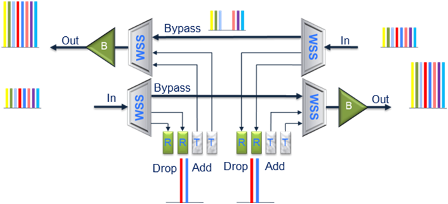Over the past decades, the use of bandwidth in transport networks increases dramatically. This resulted in the generation of wave division multiplexing (WDM) which could introduce more bandwidths on a single fiber. The need for more bandwidth flexibilities, operational efficiencies, and technology advances brought the optical add/drop multiplexer (OADM) to add or drop wavelengths at a node point. FOADM, an initial type of OADM, which uses fixed lasers for fixed wavelengths has emerged. But it can’t meet the needs of bandwidth. So this drives the emergence of the other kind of OADM – ROADM.
ROADM (reconfigurable optical add/drop multiplexer) adds the ability to remotely switch traffic from a WDM system at the wavelength layer. It avoids the unnecessary optical-electrical-optical conversion. And it’s bit-rate/protocol transparent, so future upgrades of bit-rate/protocol can be accommodated without upgrading the switch. ROADM technology has revolutionized optical network and offered huge bandwidth for data transport.
ROADM is an integral part of WDM networks due to its advantages. ROADM allows for remote configuration and reconfiguration. The planning of entire bandwidth assignment does not need to be carried out during initial deployment of a system. The configuration can be done as required without affecting traffic already passing the ROADM. It provides full flexibility of delivering any wavelength to any node throughout the ring infrastructure. It automates the optical layer to remove error-prone service provisioning, and equalizes signal loss across all wavelengths, reducing the need for expensive signal boosting equipment. What’s more, it can reduce the costs of networks.
ROADM functionality firstly appeared in long-haul equipment. By 2005, it started to appear in metro optical systems because of the network traffic driven by the increasing demand for packet-based services such as Ethernet, high-speed data, audio and video services. ROADM equipment is used to build a versatile, agile and quickly provisioned optical transport network. This transport network can scale in both distance and number of nodes.
As the continuous development of technology, it brings three generations of ROADM. The 1st generation was to solve fiber exhaust problems caused by inflexibility in the long haul networks. Compared with the 1st generation, the 2nd generation ROADM is typified by wavelength blocker technology. And the structure design of the 2nd generation is simple with a tap (a splitter and filter array) used to drop any number of selected wavelengths. But if all wavelengths enter the blocker, the pass-through wavelengths will not be blocked. The 3rd generation is the wavelength selective switch (WSS) (see the following picture). It’s more versatile, smaller, consuming less power and cheaper than 2nd generation ROADM.

Common advantages of ROADM like automatic performance monitoring and equalization make WDM systems more useful. However, the current ROADM technology is not perfect and still needs to be upgraded. The development of the advanced ROADM depends on the growth of supporting optical components maturity, progress of integrated optics technology, improved capability of the equipment and new algorithms. Whatever, the new design should concern those factors such as the future broadband communication network service needs, fewer components, fewer devices in network, effective interoperability and the flawless service evolution with considerable decrease in the operational costs.